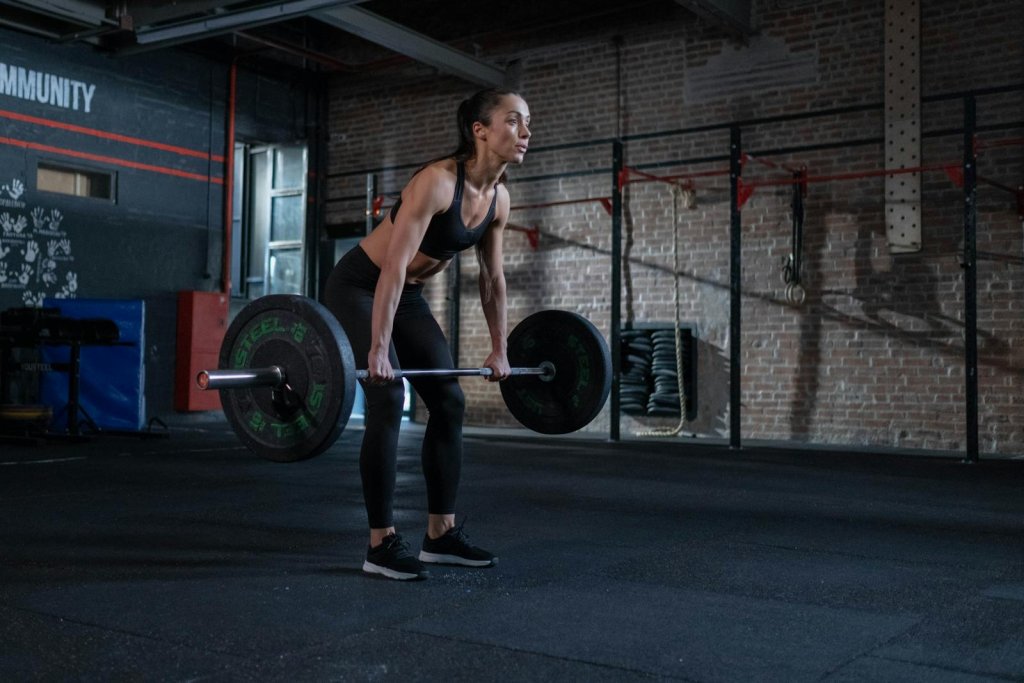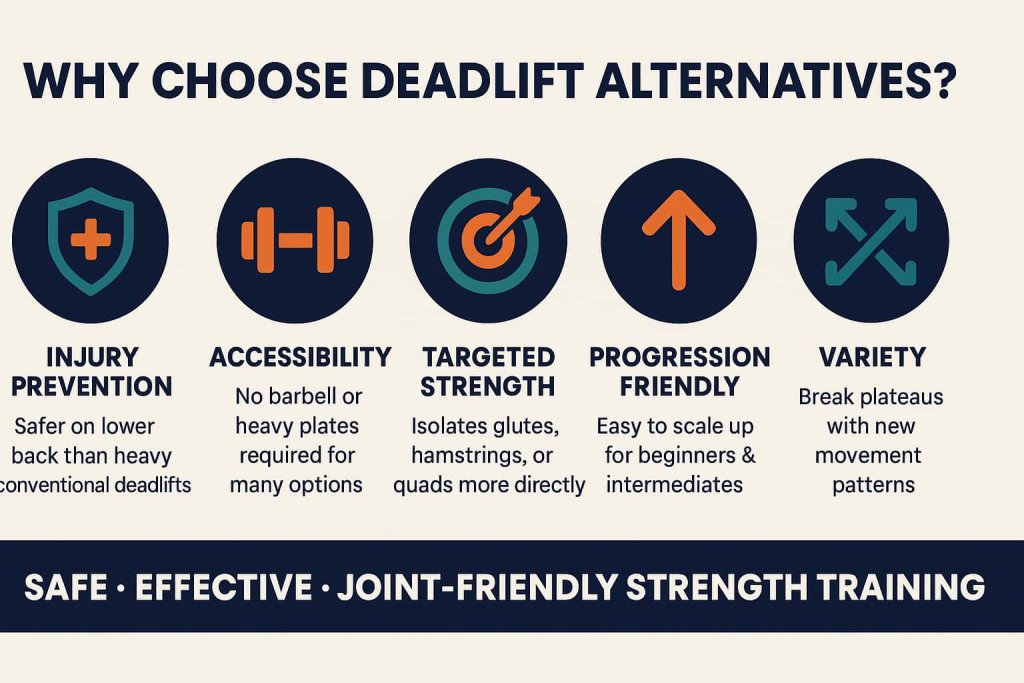You can build serious strength without traditional deadlifts — and do it safely. Conventional deadlifts are powerful for developing total-body strength, but they’re not always the best choice for everyone. Many lifters deal with lower-back pain, mobility limitations, or form breakdown that can make heavy deadlifting risky.

The good news? There are several safe deadlift alternatives that still target the same major muscles — glutes, hamstrings, core, and back — while reducing stress on the spine.
Understanding these alternatives is key because you don’t have to sacrifice progress for safety. Whether you train at home, in the gym, or just want more back-friendly options, these 12 exercises will help you build strength, improve athletic performance, and protect your joints.
Why Choose Deadlift Alternatives?

Before diving into the exercises, here’s why alternatives are valuable:
- Injury Prevention: Safer on the lumbar spine compared to heavy conventional deadlifts.
- Accessibility: No barbell or heavy plates required for many options.
- Targeted Strength: You can isolate glutes, hamstrings, or quads more directly.
- Progression Friendly: Easier to scale up for beginners and intermediates.
- Variety: Helps break through plateaus by training similar patterns differently.
These benefits make alternatives not just “substitutes” but sometimes better training tools depending on your goals.
12 Best Deadlift Alternatives for Strength, Size & Safety
The deadlift is one of the best compound lifts, but it’s not for everyone. Some lifters experience back pain, mobility limitations, or recovery issues when pulling heavy from the floor. Luckily, there are many deadlift alternatives that build strength, muscle, and athleticism—often with less spinal stress.
Here’s a complete list of the 12 best deadlift alternatives and why they deserve a spot in your training program.
1. Trap Bar Deadlift
The trap (hex) bar lets you stand inside the frame and lift with a neutral grip. Because the load is aligned with your center of gravity, it’s safer on the spine and easier for beginners.
- Muscles worked: Quads, glutes, hamstrings, traps, forearms.
- Why it’s safer: A more upright torso reduces shear force on the lower back.
- Effectiveness: Studies show trap bar deadlifts allow lifters to move heavier loads while lowering lumbar strain.
- Trainer tip: Think “squat and drive” — push through your heels, keep chest tall, and focus on hip extension.
2. Romanian Deadlift (RDL)
A hip-hinge staple, the RDL starts from the top, focusing on the eccentric lowering phase to maximize hamstring stretch and glute activation.
- Muscles worked: Hamstrings, glutes, spinal erectors.
- Why it’s effective: Emphasizes stretch-mediated hypertrophy, proven to boost muscle growth.
- Safety note: Less stress on the lower back than conventional deadlifts.
- Trainer tip: Keep a soft knee bend, push hips back, and lower the bar only until hamstrings stretch — don’t round your spine.
3. Barbell Hip Thrust
One of the best glute builders according to EMG research. It loads the hips directly while minimizing spinal compression.
- Muscles worked: Glutes, hamstrings, core stabilizers.
- Why it’s safer: Force is applied at the pelvis, not the lumbar spine.
- Effectiveness: Superior glute activation compared to squats and deadlifts.
- Trainer tip: Squeeze glutes hard at the top and pause 1–2 seconds for maximum contraction.
4. Good Mornings
A lighter barbell hip hinge that strengthens the posterior chain while teaching proper spinal alignment.
- Muscles worked: Hamstrings, glutes, spinal erectors.
- Why it’s effective: Trains hip hinge mechanics and spinal stability.
- Safety note: Keep the load moderate — too heavy can compress the spine.
- Trainer tip: Maintain a neutral back and control the descent; stop when your torso is nearly parallel to the ground.
5. Kettlebell Swing
A dynamic power movement that builds explosive hips without heavy spinal loading.
- Muscles worked: Glutes, hamstrings, core, shoulders (secondary).
- Why it’s safer: Uses lighter weight with momentum-driven hip extension.
- Effectiveness: Great for power, conditioning, and athletic carryover.
- Trainer tip: Don’t squat the kettlebell — hinge at the hips and snap them forward to drive the swing.
6. Reverse Hyperextension
A rehab-friendly movement popularized by Westside Barbell’s Louie Simmons.
- Muscles worked: Glutes, hamstrings, erector spinae.
- Why it’s safer: Strengthens the posterior chain while simultaneously decompressing the spine.
- Effectiveness: Excellent for lifters recovering from back strain.
- Trainer tip: Keep movements slow and controlled; avoid swinging the legs.
7. Glute Bridge
A beginner-friendly alternative to hip thrusts that requires no equipment.
- Muscles worked: Glutes, hamstrings.
- Why it’s effective: Builds hip strength and posterior chain endurance.
- Safety note: Perfect for home training or warm-ups.
- Trainer tip: Use a resistance band just above the knees to activate glute medius.
8. Single-Leg Romanian Deadlift
A unilateral RDL that challenges balance, stability, and core control.
- Muscles worked: Glutes, hamstrings, calves, core.
- Why it’s safer: Uses lighter loads but forces the body to stabilize.
- Effectiveness: Corrects muscle imbalances and strengthens stabilizers.
- Trainer tip: Start with bodyweight, then progress to holding dumbbells or kettlebells.
9. Cable Pull-Through
Performed with a cable machine or resistance band, this mimics the hip hinge with constant tension.
- Muscles worked: Glutes, hamstrings, spinal stabilizers.
- Why it’s safer: Keeps load behind the body, reducing spinal compression.
- Effectiveness: Great accessory for glute development.
- Trainer tip: Drive hips forward — avoid pulling with arms.
10. Bulgarian Split Squat
A single-leg squat variation that heavily recruits quads and glutes.
- Muscles worked: Quads, glutes, hamstrings, core.
- Why it’s effective: Improves balance, mobility, and unilateral strength.
- Safety note: Less spinal load than bilateral squats/deadlifts.
- Trainer tip: Keep torso upright, use dumbbells for added load, and control depth.
11. Bent-Over Row
While not a hip hinge, this compound back builder strengthens spinal erectors and upper back — muscles essential for pulling strength.
- Muscles worked: Lats, rhomboids, traps, erectors.
- Why it’s useful: Reinforces posture and back stability for deadlift-type movements.
- Trainer tip: Keep torso rigid, avoid jerking, and pull bar toward your midsection.
12. Sumo Deadlift or Block Pulls
Modified deadlift variations that reduce lumbar stress while keeping heavy pulling in your program.
- Muscles worked: Glutes, hamstrings, quads, traps.
- Why it’s safer: Sumo stance shortens the range of motion; block pulls elevate the bar to limit hip flexion.
- Effectiveness: Ideal for lifters with hip or back discomfort during conventional pulls.
- Trainer tip: Keep knees pushed out in sumo; focus on leg drive, not just pulling.
Key Training Tips
- Start with 2–3 alternatives per session for balanced posterior chain training.
- Prioritize form over weight to avoid injury.
- Use both bilateral (trap bar, RDL) and unilateral (single-leg RDL, Bulgarian split squat) exercises.
- Progress gradually by adding reps, sets, or resistance bands before heavy weights.
FAQs
1. Are deadlift alternatives as effective as barbell deadlifts?
Yes. Exercises like trap bar deadlifts and hip thrusts build similar muscles with lower injury risk.
2. What’s the best alternative for beginners?
Glute bridges and Romanian deadlifts are safe, simple starting points.
3. Can I still grow my glutes without deadlifts?
Absolutely. Hip thrusts and Bulgarian split squats are among the best glute-builders.
4. Which option is best if I have lower-back pain?
Cable pull-throughs, reverse hypers, and hip thrusts are lower-back friendly.
5. Do I need a barbell for these exercises?
No. Many can be done with dumbbells, kettlebells, or just bodyweight.
6. Should I replace deadlifts entirely?
If deadlifts cause pain, yes. Otherwise, use these as supplemental lifts.
7. How often should I do them?
2–3 times per week, depending on your recovery and program.
Conclusion
Deadlifts are a gold-standard strength exercise, but they’re not the only way to build a powerful posterior chain. With these 12 deadlift alternatives, you can target the same muscles safely, reduce injury risk, and even improve specific weaknesses. Start with bodyweight-friendly options like glute bridges, progress to RDLs and kettlebell swings, and incorporate trap bar deadlifts or hip thrusts as you get stronger.
